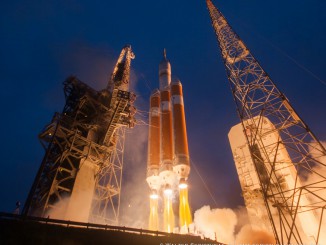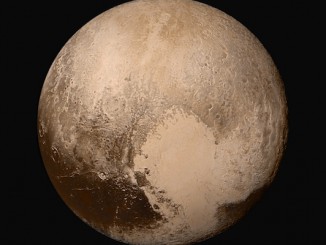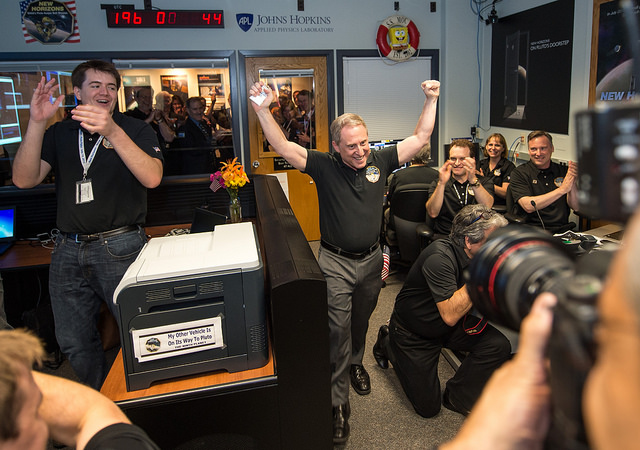
A long-awaited radio signal from NASA’s New Horizons spacecraft landed on planet Earth late Tuesday, confirming the faraway space probe performed as expected during a one-shot flyby of Pluto at the solar system’s outer frontier.
“Once again, we have achieved a historic first,” said NASA Administrator Charles Bolden. “The United States is the first nation to reach Pluto … There is no other nation in the world that has the capability in doing that, but we did it. It has been a long time coming. For some of the team, it’s been like a lifetime.”
The first carrier tone arrived at a NASA Deep Space Network antenna near Madrid right on time at 8:52:37 p.m. EDT Tuesday (0052:37 GMT Wednesday), ending a nearly 22-hour radio blackout as the probe focused on a series of close-up observations of Pluto and its moons.
New Horizons transmitted the radio message just before 4:30 p.m. EDT (2030 GMT), but the signal — even traveling at light speed — did not arrive on Earth until four-and-a-half hours later.
Engineers initially locked on to a carrier signal, then started receiving housekeeping data on the status of the New Horizons spacecraft. No science data was expected to come down during Tuesday night’s pass.
Alice Bowman, New Horizons’ mission operations manager, polled communications, guidance, electrical, thermal and propulsion subsystem teams to confirm the probe was healthy after the Pluto flyby earlier Tuesday just before 7:50 a.m. EDT (1150 GMT) at an altitude 7,700 miles above Pluto’s salmon-colored surface.
The status reports were all green, and Bowman reported to New Horizons’ principal investigator Alan Stern: “We have a healthy spacecraft. We have recorded data on the Pluto system. We’re outbound from Pluto.”
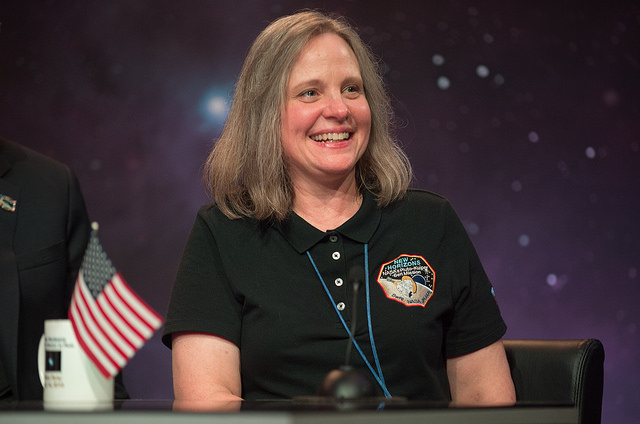
The announcement triggered a wave of applause and emotional hugs among hundreds of New Horizons scientists and invited guests gathered at the Johns Hopkins University Applied Physics Laboratory in Laurel, Maryland, where the $720 million NASA mission was built as is now controlled.
“I have never been one to underplay the significance of this mission,” said Stern, who spearheaded a more than decade-long movement to get NASA approval to build and launch a Pluto probe. “I’d like to characterize that DSN (Deep Space Network) pass that you just watched as one small step for New Horizons, and one giant leap for mankind.”
Bowman, whose position is known by the acronym MOM, said the spacecraft had no problems during the encounter and telemetry indicated New Horizons’ dual data recorders were filled with information collected at Pluto.
Although officials said the chance of a problem during Tuesday’s flyby was very low, New Horizons was heading into the unknown. There was a slight chance the probe could have crashed into a pebble or dust particle, crippling the spacecraft.
Bowman’s position as MOM cast the engineer as a parental figure for the robot as it traveled nearly three billion miles from Earth, nine-and-a-half years after liftoff from Cape Canaveral.
“You have a lot of faith in your children, but sometimes they don’t do exactly what you expect them to do,” Bowman said. “It’s that feeling you want them to be home at eight o’clock, but they’re not there, so you worry. In this instance, our spacecraft did exactly what it was supposed to do, and the signal was there for us to capture. It was great.”
The communications silence was part of the plan going into the flyby because New Horizons carries a fixed antenna, meaning mission managers have to choose between contacting Earth and conducting scientific work at Pluto.
Before Tuesday night, engineers last heard from New Horizons at 11:17 p.m. EDT Monday (0317 GMT Tuesday), when the craft downlinked an image taken of Pluto from a range of 476,000 miles, showing striking boundaries between bright and dark regions that scientists are eager to understand.
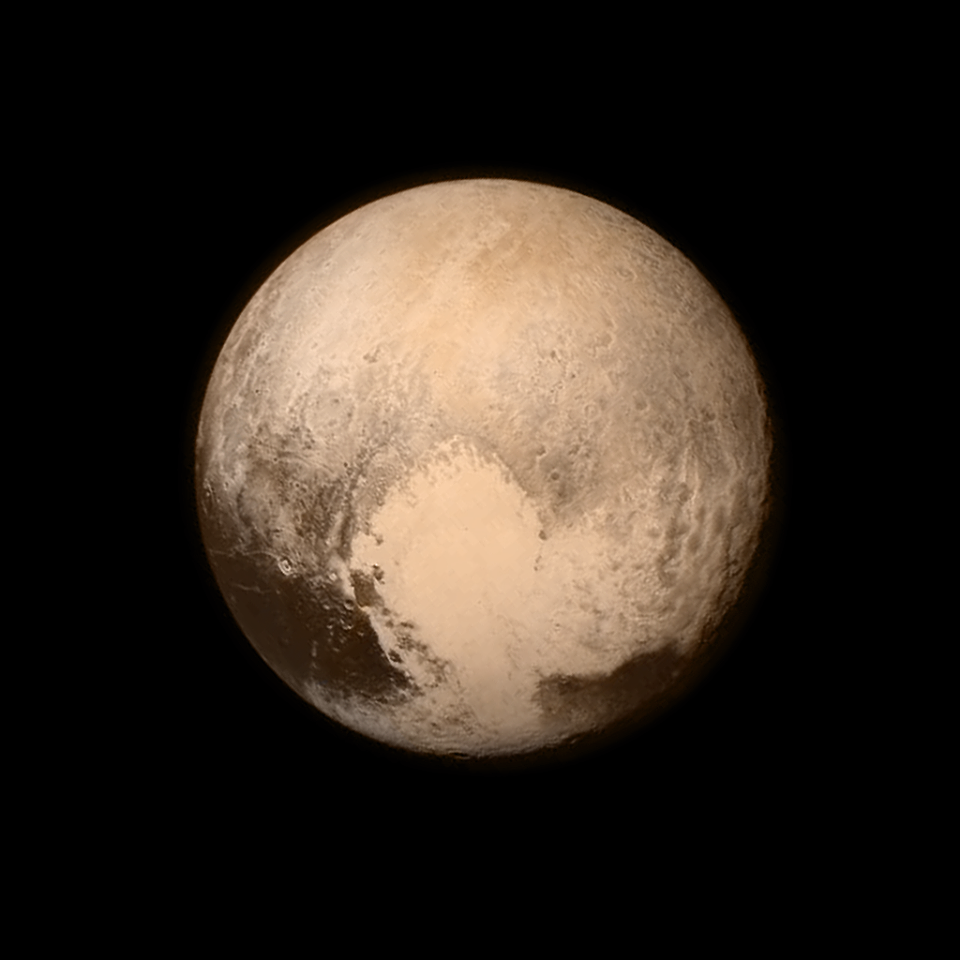
The next dump of science data from New Horizons is expected to begin at 5:50 a.m. EDT (0950 GMT) Wednesday, Stern said.
“It’s something that we have called the New York Times dataset because we think it’s going to be pretty interesting,” Stern said in a press conference Tuesday night.
“Included in that dataset will be new imagery at 10 times higher resolution than the spectacular imagery debuted this morning,” Stern said. “Additionally, there will be information from the two spectrometers — from Alice and from the Ralph spectrometer, new color data, information on not just Pluto, but also Charon and also the small satellites.
“There’s going to be quite a waterfall of data for us tomorrow morning, and we’re going to be reporting on what we find at (3 p.m. EDT in a press conference),” Stern said.
After the brief contact with Earth late Tuesday, which occurred as New Horizons flew more than 400,000 miles outbound from Pluto, the probe turned its instruments back toward the icy world for more observations.
“The reason why you’re not seeing more things immediately is because the spacecraft is spending all its time making the observations of the Pluto system,” says Hal Weaver, New Horizons’ project sciences from APL. “That’s what we wanted to do. Of course, you want to optimize the scientific return from the mission.”
Weaver said the first post-flyby science transmission will be a package of high-resolution images, data on Pluto’s atmosphere as the probe flew outbound from the icy world, and information on the space environment around Pluto. Officials expect:
- Pluto stereo footprints (3) at 0.24 miles/pixel
- Charon photo at 1.4 miles/pixel
- Hydra photo at 2.0 miles/pixel
- Nix photo at 1.8 miles/pixel
- Pluto occultation count rates
- Radio Science Experiment temperature measurements of Pluto’s night side
- Alice airglow spectra
- SWAP data on solar wind-atmospheric interaction
- PEPSSI data on pickup of molecules from Pluto’s atmosphere
Email the author.
Follow Stephen Clark on Twitter: @StephenClark1.

